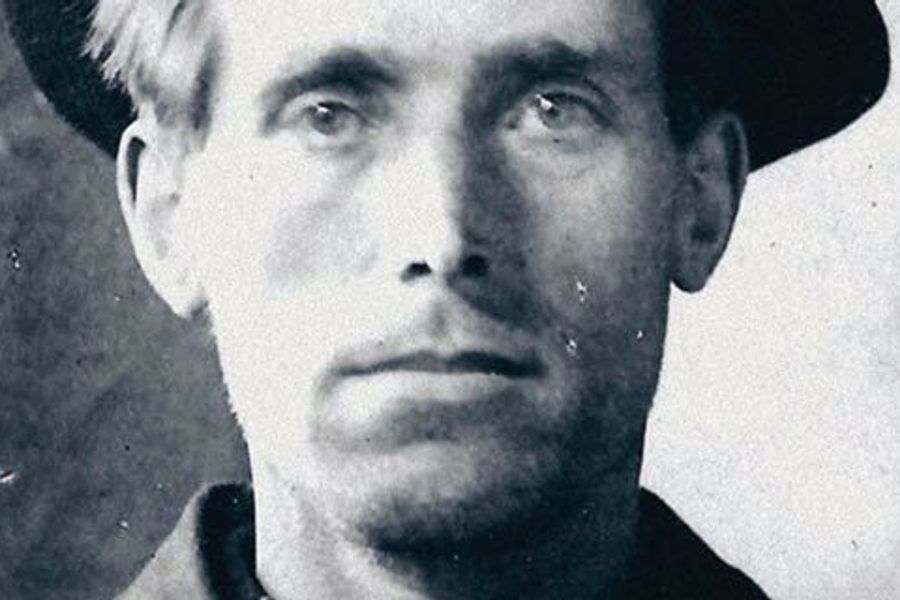
Did the executed IWW radical do more for labor movement while dead or alive?
The basic facts removed from political context could lead any reasonable armchair sleuth to suspect legendary IWW union singer Joe Hill killed shopkeeper John Morrison on a frigid, snowy night in Salt Lake City in January 1914. The attacker was reportedly shot by Morrison’s son – also murdered that night, and soon after Hill showed up at a Socialist doctor’s house with a gunshot wound that he wanted to keep quiet.
Hill never provided an alibi, nor did the two people who his supporters say could have cleared him of the crime – the friend who they say shot him over a woman, or the woman herself.
In his new book The Man Who Never Died, Colorado author William Adler delves into the case’s evidence, motives and lack thereof with the spirit of a private investigator, smoothly combined with the detachment of an historian and the passion of an activist. The result is a multi-layered whodunnit that ultimately, he thinks, exonerates Hill and raises the more mysterious question of why Hill accepted execution without ever trying to prove his innocence.
There was nothing overtly political about the double-murder of Morrison and his son, and Hill’s initial arrest seems reasonable enough given the unexplained gunshot wound. But Adler shows how Utah state officials turned the case into something much greater – basically putting the Wobblies and the whole notion of anti-capitalism on trial at a time free speech and labor struggles were mushrooming in cities, docks, mines and work camps nationwide.
“He began to see himself as his supporters around the world saw him – as this heroic symbol of courage and conviction and rebellion,” Adler told In These Times, from a book tour that has him and his family circumnavigating the country in a van – a welcome relief after “five years in the basement” writing the book. “Once he saw himself that way, he probably felt that he couldn’t back down. He was a victim of his own celebrity.”
Adler thinks Hill’s insistence on playing the martyr role was compounded by a somewhat naïve faith in the justice system. At least until the very end he never really believed he would be convicted, and he steadfastly maintained it was not his responsibility to prove innocence but rather the state’s burden to prove guilt.
At the time, many of Hill’s supporters begged him to speak up in his own defense, arguing he could do more for the movement alive than dead. But with the benefit of hindsight, Adler’s not sure that’s true.
The radical labor movement was destined to fall apart anyway whether he lived or died, when America entered World War I and started to clamp down on Wobblies for their antiwar stance – they said the only war is class war. The IWW as a viable movement back then was going to be done in a couple years anyway, but Hill as a symbol has certainly endured – in that sense he was right. A lot of unions and progressive organizations that Hill might not have agreed with philosophically have embraced his call for solidarity – not to mourn, to organize.
Along with the details of the case, Adler paints an engaging and inspiring picture of the Wobbly movement in its prime, when cadres of hobos hopped trains – or marched through the snow for miles – to converge on cities where local officials were trying to stamp out the movement with blatantly unconstitutional bans on public speaking. There were elements of humor, the surreal and brave resistance in the “jawsmith” strategy of stepping up to the soapbox one after another to be systematically arrested until they overwhelmed the jails.
Adler also puts the drama in the context of the rush to develop the western states, with robber barons and their minions scrambling to build railroads, mines, irrigation systems and cities, drawing waves of migrant and largely immigrant workers from the east to do their bidding. The Wobblies were a serious threat and unacceptable insult to this exalted manifestation of unfettered capitalism, as prosecutors made amply clear in their courtroom statements against Hill.
Adler — also the author of Mollie’s Job: A Story of Life and Work on the Global Assembly Line and Land of Opportunity: One Family’s Quest for the American Dream in the Age of Crack—writes:
The West is where the unskilled jobs were, where wage-workers were needed to dig and saw and pick and blast natural resources from the recently tamed frontier, to haul and sort and refine the raw materials, and to pack the resultant commodities and ship them to distant markets and industrial centers. The economy was boom and bust. A dip in, say, the spot price of copper could trigger swells of unemployment that rippled like harvest wheat. Even in boom times, however, employment agents kept their skid road hiring halls overflowing with surplus workers. And surplus workers – regardless of the going rate for copper futures – ensured surplus misery: low wages, long hours and appalling living and working conditions.
Hill’s songs enshrined and celebrated the hardscrabble lives of these workers and mocked and lambasted the greed and inhumanity of their bosses. Adler isn’t the first to memorialize and explore Hill’s life and legacy. For example, renowned Western writer Wallace Stegner’s 1950 reality-based novel Joe Hill paints him as a flawed hero who may or may not have been innocent of the murder. But Adler apparently did much more boot-leather research than Stegner or other chroniclers, and uncovered what he sees as a key piece of evidence supporting Hill’s innocence.
That would be a letter from the woman – a fellow Swedish immigrant – who broke off an engagement with Hill’s friend in a love triangle that they say led to Hill’s bullet wound. And Adler introduces another fascinating character into the story — Magnus Olson, a Norwegian immigrant and career criminal with multiple aliases who may well have been the real killer of John Morrison.
The parallel narratives of Joe Hill and Magnus Olson are a riveting and clever way to show the rough and tumble, hand-to-mouth world of working-class European immigrants, who in this case took very different routes in a politically and economically unforgiving new world. It is telling that the man ultimately executed was the one who did not actually attack property or people, but rather with his songs and symbolism posed a far greater threat to the status quo.
At a reading in Boulder last month, Adler lamented the fact that Hill is celebrated as a historical figure while the radical and direct nature of his politics is glossed over in the public consciousness — instead of being embraced and made relevant to the current context. Though Adler hopes the Occupy Wall Street protests signify a re-emergence of direct action and grassroots organizing, he said he doesn’t see any contemporary Joe Hills out there:
In terms of music, there are plenty of singer-songwriters writing protest music – but the difference is they perform. Hill was not a performer – he wrote topical songs to be sung by workers. He was an organizer, an extreme person, who believed that if a cause is worth living for, it’s worth dying for.

I hope you found this article important. Before you leave, I want to ask you to consider supporting our work with a donation. In These Times needs readers like you to help sustain our mission. We don’t depend on—or want—corporate advertising or deep-pocketed billionaires to fund our journalism. We’re supported by you, the reader, so we can focus on covering the issues that matter most to the progressive movement without fear or compromise.
Our work isn’t hidden behind a paywall because of people like you who support our journalism. We want to keep it that way. If you value the work we do and the movements we cover, please consider donating to In These Times.
Kari Lydersen is a Chicago-based journalist, author and assistant professor at Northwestern University, where she leads the investigative specialization at the Medill School of Journalism, Media, Integrated Marketing Communications. Her books include Mayor 1%: Rahm Emanuel and the Rise of Chicago’s 99%.







